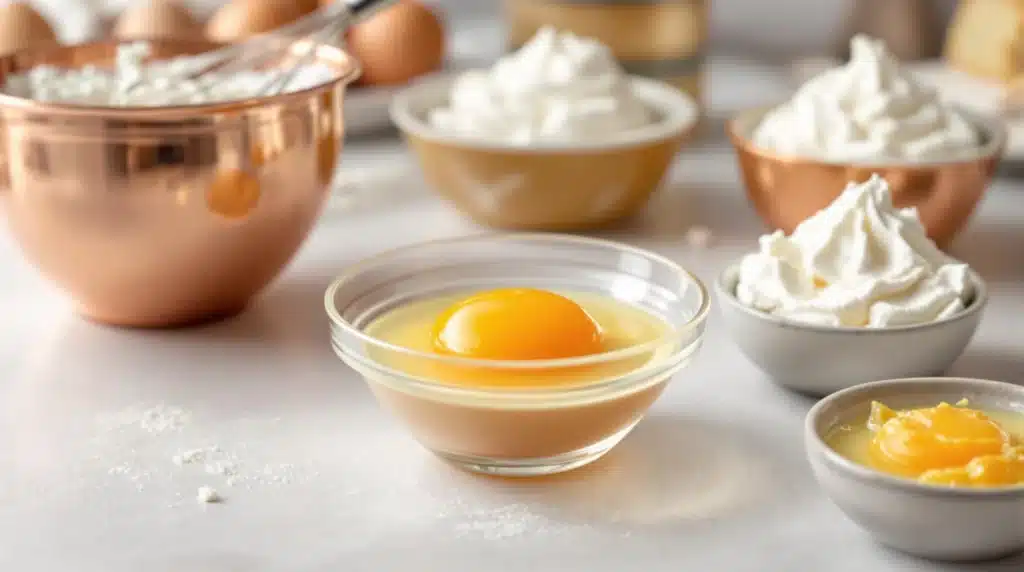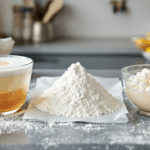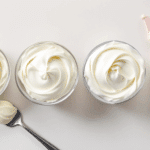Scan through almost any baking recipe – from lofty cakes and chewy cookies to creamy custards and enriched breads – and you’ll inevitably find eggs listed among the key ingredients. We might take them for granted, thinking of them primarily as a simple binder or perhaps adding a bit of richness. But the humble egg is one of baking’s true multi-tasking powerhouses, performing a remarkable array of functions that go far beyond simply holding things together.
For aspiring bakers, understanding the diverse and crucial roles eggs play is fundamental. Why do some recipes call for whole eggs, others just yolks, and still others just whites? Why does the temperature of the eggs sometimes matter? Failing to appreciate the science behind eggs in baking can lead to mysterious failures – cakes that collapse, meringues that weep, or textures that just aren’t quite right. Let’s crack open the secrets of this incredible ingredient and explore the “egg-cellent” ways eggs contribute to structure, leavening, richness, color, moisture, and more, giving you the insights needed to use them effectively.
Anatomy of an Egg (The Baker’s Perspective)
To understand how eggs work in baking, it helps to know their basic components:
- Yolk: The vibrant yellow center. It’s rich in fat, lecithin (a powerful emulsifier), proteins, vitamins, minerals, and the pigments that give it color. From a baking perspective, the yolk primarily contributes richness, flavor, color, tenderness (due to fat), and emulsifying power.
- White (Albumen): The clear, viscous substance surrounding the yolk. It’s composed mainly of water (about 88%) and various proteins (primarily albumin). The whites are fat-free. In baking, their key roles are providing structure when their proteins cook and set, and creating voluminous foams for leavening when whipped.
- Shell: The hard, protective outer covering. While its color (white, brown, speckled) doesn’t affect nutritional value or baking performance, its presence necessitates cracking and means eggs are typically sold in standardized sizes.
- Membranes: Thin, skin-like layers just inside the shell and surrounding the yolk, holding everything together. Less critical functionally in baking but part of the structure.
The distinct properties of the yolk and the white allow eggs to perform a wide range of jobs in our recipes.
The Multi-Tasking Marvel: Eggs’ Roles in Baking
Eggs wear many hats in the kitchen. Here are their most significant contributions to baked goods:
- Structure & Binding (The Foundation): This is arguably the most critical function, especially in items lacking a strong gluten network, like many cakes and custards. When heated, the proteins in both the egg yolks and whites coagulate – they change from liquid to solid or semi-solid. This process sets the structure of the baked good, providing shape and preventing collapse as it cools. Think of egg proteins acting like the framework or scaffolding within a cake, or the thickening agent that sets a custard. They also act as a binder, helping to hold other ingredients together cohesively.
- Leavening (Adding Airiness): Eggs contribute to leavening (making things rise) in two main ways through their ability to trap air:
- Whole Eggs & Yolks: Beating whole eggs or just yolks, particularly with sugar, incorporates air bubbles. The proteins help stabilize these bubbles, which then expand when heated in the oven, providing lift. This is a key leavening mechanism in traditional sponge cakes.
- Egg Whites: Egg whites possess remarkable foaming ability. When whipped vigorously (with a whisk or mixer), their proteins unfold and create a network that traps vast amounts of air, increasing their volume dramatically (up to 6-8 times!). This stable foam provides significant leavening power and creates exceptionally light and airy textures in foods like meringues, angel food cakes, chiffon cakes, and soufflés.
- Richness & Flavor: The fat contained within the egg yolk contributes significantly to the richness and perceived “mouthfeel” of baked goods. This fat also adds a distinct, desirable flavor note that we associate with custards, enriched breads (like brioche or challah), pound cakes, and many cookies.
- Tenderness: The fat in the yolk also contributes to tenderness. By coating some of the flour proteins, fat can slightly inhibit gluten development, leading to a softer, less chewy texture compared to fat-free alternatives.
- Moisture: Eggs have a high water content, particularly the whites. This liquid contributes to the overall hydration of the batter or dough, affecting moisture levels in the final product and helping starches to gelatinize properly during baking.
- Color: The carotenoid pigments in the egg yolk lend a warm, yellow hue to batters and doughs (like challah or pasta). Furthermore, the proteins and sugars in eggs contribute to surface browning during baking through the Maillard reaction, especially when used as an egg wash on crusts.
- Emulsification: Egg yolks are rich in lecithin, a natural emulsifier. Emulsifiers are substances that allow ingredients that normally don’t mix well – like fat and water – to blend smoothly and resist separation. This property is crucial for creating smooth, stable batters in cakes (especially those high in fat), preventing curdling in custards, and forming stable emulsions in sauces like mayonnaise or hollandaise.
- Nutrition: Let’s not forget that eggs also contribute valuable protein, vitamins (like A, D, E, K, and B vitamins), and minerals (like iron) to our baked goods.
Understanding these varied roles helps explain why eggs are such indispensable ingredients in so many different types of baking.
Cracking the Code: Practical Egg Considerations
Using eggs effectively involves more than just cracking them into the bowl. Here are some key practical points:
- Egg Size Matters: When a recipe calls for “eggs,” it almost always assumes Large eggs (which weigh about 50g out of the shell in the US). Using Medium, Extra-Large, or Jumbo eggs will alter the amount of liquid, fat, and protein in your recipe, potentially impacting hydration, structure, and richness. While minor variations might be okay in some forgiving recipes, significant size differences can cause problems in more sensitive ones (like cakes or custards). It’s best practice to stick to Large eggs unless the recipe specifies otherwise. If you must substitute, be aware of the potential impact.
- Freshness: For most general baking (cakes, cookies, breads), eggs readily available at the supermarket are perfectly fine. Extremely fresh eggs (straight from the farm) have very thick, tight whites that hold the yolk high; these are ideal for poaching but can sometimes be harder to whip to maximum volume initially. Slightly older eggs (a few days to a week or two) have whites that thin out slightly, which can sometimes make them easier to whip into voluminous foams (though some argue the foam might be slightly less stable). Avoid using very old eggs where the yolk is flat and the white is watery, as their binding and foaming properties may be diminished. (You can test freshness by placing an egg in water: fresh eggs sink and lie flat, older eggs may stand on end or float – floating eggs should be discarded).
- Temperature: Room Temp vs. Cold – It Depends! The ideal temperature for your eggs depends entirely on what you’re doing with them:
- Room Temperature Eggs: Generally recommended for incorporating into cake batters and cookie doughs, especially those using the creaming method (beating butter and sugar). Why? Room temperature eggs (around 68-70°F / 20-21°C) blend more smoothly and evenly into batters. Cold eggs can cause softened butter to re-harden and curdle the mixture, leading to a dense or uneven texture. Room temperature eggs also trap air more readily when beaten with sugar. (Quick Tip: To bring cold eggs to room temperature quickly, place them in a bowl of warm (not hot) tap water for 5-10 minutes).
- Cold Eggs: Primarily recommended when you need to separate yolks from whites. The membranes holding the yolk together are firmer when cold, making the yolk less likely to break and contaminate the whites. This is crucial if you plan to whip the whites, as even a tiny speck of fatty yolk can prevent the whites from reaching full volume. While some sources say cold whites create a more stable foam initially, room temperature whites generally whip to a greater volume. Often, recipes suggest separating eggs while cold, then letting the whites sit briefly at room temperature before whipping. Always follow your specific recipe’s guidance on egg temperature.
- Separating Eggs Like a Pro: When you need only yolks or whites, clean separation is key. The easiest method is often the “three bowl” technique:
- Crack the egg carefully on a flat surface (not the bowl edge).
- Gently pass the yolk back and forth between the shell halves over Bowl 1, letting the white drip down.
- Place the yolk in Bowl 2.
- Pour the collected white from Bowl 1 into Bowl 3 (your main whites bowl).
- Repeat with remaining eggs. This way, if you break a yolk on one egg, you only contaminate the white in Bowl 1, not your entire batch in Bowl 3. Remember: absolutely no yolk can get into whites destined for whipping!
- Egg Washes for a Finishing Touch: An egg wash is simply beaten egg (whole, yolk only, or white only), sometimes thinned with a teaspoon or two of water, milk, or cream, and optionally seasoned with a pinch of salt. It’s brushed onto the surface of doughs (like pies, pastries, breads, rolls) before baking.
- Purpose: Adds shine, promotes deeper browning (color), helps seeds or sugar toppings adhere, and can help seal pastry edges together.
- Variations: Whole egg wash gives good color and shine. Yolk-only wash gives deeper golden-brown color. White-only wash gives more shine and crispness with less color. Adding milk/cream softens the crust slightly compared to water.
Egg Substitutions (A Word of Caution)
With various dietary needs, substitutes like “flax eggs” (flaxseed meal + water), “chia eggs” (chia seeds + water), applesauce, mashed banana, silken tofu, or commercial egg replacers are sometimes used.
However, it’s crucial to understand that eggs perform many complex functions simultaneously. While a substitute might replicate one function (like binding or moisture), it rarely replaces all of them effectively, especially the structural and leavening contributions of egg proteins.
Therefore, directly substituting eggs in traditional baking recipes often leads to significantly different – and frequently disappointing – results, particularly in texture, rise, and richness. For reliable outcomes, it’s almost always better to seek out recipes specifically developed and tested using those egg substitutes rather than trying to adapt a conventional recipe.
Conclusion: The Indispensable Egg
Far from being a simple binder, the egg is a culinary chameleon, playing a multitude of indispensable roles in the baker’s kitchen. Its proteins provide essential structure, its whites whip into airy foams for leavening, its yolk delivers richness, color, and emulsifying power, and its overall composition contributes moisture and binds everything together.
By understanding these “egg-cellent” functions, aspiring bakers can appreciate why recipes call for eggs and how they impact the final product. Paying attention to practical details like egg size, the importance of temperature for different applications, and the techniques for separating or whipping them correctly, elevates your baking from guesswork to informed practice. While substitutions exist for dietary reasons, recognize their limitations in conventional recipes. Embracing the power and versatility of the humble egg is a key step toward achieving consistently delicious and well-structured baked goods.







